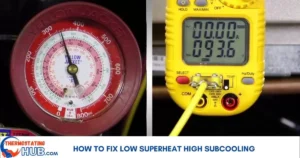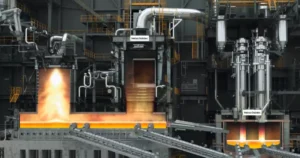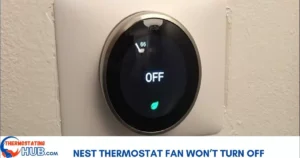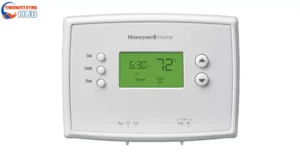If your Nest thermostat is blasting hot air when you’ve set it to cool, you’re in the right place for solutions.
Usually, if your Nest is blowing warm air on a cool setting, it might be because of your thermostat setup or having a conventional heating system. An incorrect heat pump orientation (O/B) setting could also be causing this issue.
Take a peek at the table below that outlines potential reasons why your Nest isn’t cooling properly.
It’s frustrating when your thermostat doesn’t cooperate, especially during temperature changes. Checking these settings and configurations could help get your Nest back on track to keep your place at the perfect temperature. Don’t let thermostat troubles ruin your comfort!
5 Possible reasons a Nest thermostat is blowing hot air on cool
| Possible Cause | Main Fix |
| Thermostat settings | Confirm your thermostat is in cooling mode (snowflake symbol) |
| Conventional heating system | Consider an alternative cooling system |
| Stuck reversing valve | Replace the solenoid or reverse valve |
| Incorrect Nest orientation (O/B) settings | Correctly adjust the (O/B) setting |
| Incorrect thermostat wiring | Ensure proper wiring of your thermostat |
Now, let’s delve into the specifics of troubleshooting the issue.
Understanding the intricacies of your thermostat’s settings and connections can significantly impact its performance. Taking the time to troubleshoot and rectify these issues can ensure your system operates smoothly. Don’t hesitate to refer to the provided solutions to tackle any potential problems, keeping your HVAC system running optimally!
Read also: AC High Pressure Line Hot Or Cold
Thermostat settings
When you realize your Nest is blowing hot air instead of cool, the first thing to check is the thermostat settings. It might seem obvious, but often, the entire issue stems from the thermostat not being set to cooling.
If this issue persists despite adjusting the settings, consulting a professional technician for further inspection and assistance could be beneficial. Remember, regular maintenance helps prevent such surprises!
Solution
Make sure the thermostat displays a snowflake symbol, indicating that it’s set to cooling mode.
Remember, always check the thermostat’s symbol for cooling to ensure a comfortable temperature in warmer weather. Adjusting the settings accordingly can help maintain a pleasant indoor climate.
You have conventional Heating system
Truthfully, differentiating between a heat pump and a conventional heating (furnace) system can be puzzling, especially for new homeowners. However, there are techniques to discern which system you have. First, check for a label or sticker on the unit. If it’s not there, try looking up the model number online for more information.
Another method is examining the wiring of your thermostat. A heat pump usually has a wire connected to the O/B terminal, whereas a conventional heating system might lack this wire.
For heat pump systems, activating the heating mode should engage the outdoor unit.
To confirm if you have a heat pump, conduct a diagnostic test:
- Set your thermostat to cool mode (ensure the snowflake symbol displays).
- Lower the temperature setting below the current room temperature.
- Wait a few minutes and feel the air from the vents. If it’s cool, you likely have a heat pump. If not, check the O/B wire settings.
Remember, running these diagnostic steps can help you identify your system type, ensuring proper troubleshooting and maintenance.
Read also: What is Nest Heat Pump Balance?
Wrong Nest Heat Pump Orientation (O/B) settings

If your HVAC system is blowing warm air when it should be cooling and vice versa, there might be an issue with the O/B wire setting on your thermostat. The O/B settings are responsible for managing the reversing valve. 👍
Ensuring your thermostat’s O/B wire setting is correctly configured is vital for your HVAC system to operate efficiently. Proper configuration helps in maintaining the desired temperature settings and ensures your comfort throughout the seasons. If you’re experiencing inconsistent air temperatures, checking and adjusting this setting can often resolve the issue, saving you from potential discomfort.
Solution
To troubleshoot this issue, you’ll need to adjust the O/B wire settings either on the thermostat or through the App.
For Nest Learning Thermostat and Thermostat E, take these steps:
- Access Settings by tapping on the Nest settings icon on your thermostat.
- Choose Equipment.
- Select Continue, then Continue again.
- Opt for a Heat Pump.
- By default, the Nest Thermostat is set to an O option for heat pumps.
- If the O option is highlighted, switch to B.
- If the B option is highlighted, switch to O.
- Test your heating and cooling to ensure the issue is resolved.
If you’re using a Nest thermostat, follow these instructions:
- Open the Google Home app.
- Tap on your thermostat.
- At the top right, select Settings.
- Choose Thermostat.
- Scroll down to find Heat pump and check the current wire configuration.
- If the O option is highlighted, change it to B.
- If the B option is highlighted, change it to O.
- Test your heating and cooling to confirm the resolution of the issue.
Properly configuring the O/B wire settings on your thermostat, whether through the device or the app, can effectively address the incorrect air temperature issue, ensuring your HVAC system operates according to your preferences. Following these simple steps should help you achieve the desired heating and cooling settings in your home or space.
Stuck reversing valve
Occasionally, with a heat pump, you might notice it blowing warm air when set to cool. This issue could result from a stuck reversing valve.
The purpose of a reversing valve is to alter the refrigerant’s direction, allowing the heat pump to function as both an air conditioner and a heating system.
Over time, the reversing valve can develop defects, particularly in one direction (either for cooling or heating). This can lead the heat pump to operate solely in either heating or cooling mode.
Typically, when the reversing valve malfunctions, it’s often due to damage or burning in its coil solenoid.
The proper functioning of the reversing valve is crucial for your heat pump to efficiently manage both cooling and heating. Any issues with this valve, especially damage to its coil solenoid, can result in the heat pump working incorrectly. Regular maintenance and timely repairs can help prevent these problems, ensuring your heat pump operates optimally year-round.
Read also: How To Fix E298 Nest ‘no Power Code
Solution
To resolve this issue, replacing the solenoid coil is necessary, yet it needs testing with a multimeter to confirm it’s the root cause. However, if the entire reversing valve is faulty, a complete replacement becomes essential to rectifying the problem. This repair addresses the issue effectively.
Diagnosing and fixing issues with the reversing valve can involve troubleshooting the solenoid coil using a multimeter. Accurate testing helps determine whether the solenoid coil is the culprit. In cases where the entire valve is defective, replacing it becomes the ultimate solution, ensuring your heat pump operates smoothly. Professional assistance may be advisable for these repairs to ensure precision and efficiency in resolving the problem.
Wrong thermostat wiring
Incorrect thermostat wiring could potentially be the cause if your Nest isn’t cooling properly. It’s crucial that the wiring on your Nest thermostat aligns with the type of system you’re using.
For instance, the wiring for a single-stage heat pump varies from that of a two-stage heat pump. Here are wiring diagrams illustrating different types of heat pump systems.
Ensuring your Nest thermostat’s wiring matches your specific heat pump system type is essential for its proper functioning. The provided wiring diagrams offer a visual guide to assist in correctly configuring your thermostat, avoiding potential issues that might hinder the cooling process. Proper wiring alignment ensures efficient cooling and heating operations according to your system’s requirements.
1st stage heat pump
| Label | Function |
| Y1 | Compressor relay stage 1 |
| G | Fan Relay |
| O/B | Heat pump changeover valve |
| Rc | 24 VAC power from cooling transformer |
| C | Common wire |
Understanding the functions of each labeled component is essential for efficient system operation. Identifying these elements helps in troubleshooting and ensuring the proper functioning of the equipment. Properly configuring and maintaining these parts is key to the smooth operation of the system.
2nd stage heat pump
| Label | Function |
| Y1 | Compressor relay stage 1 |
| Y2 | Compressor relay stage 2 |
| G | Fan Relay |
| O/B | Heat pump changeover valve |
| Rc | 24 VAC power from cooling transformer |
| C | Common wire |
Recognizing the distinct roles of every labeled component is crucial for ensuring the efficient operation of the system. Understanding these functions aids in troubleshooting and maintaining the system to guarantee its proper functioning.
Answers to key questions
What is the life expectancy of a Nest thermostat?
The life expectancy of a Nest thermostat is typically around 10-15 years.
How do I know if my nest is bad?
If your Nest thermostat frequently loses connection, stops responding to changes, or displays errors consistently, it might be faulty.
Will Nest tell you if AC isn’t working?
Nest can indicate an issue by displaying an alert or notification if it detects a problem with your AC system.
How can you tell if your thermostat is bad on your AC?
If your thermostat doesn’t respond to settings, displays incorrect temperatures, or fails to turn on your AC, it might indicate a problem with the thermostat.
Why is my AC blowing cold air but not cooling the house?
This issue could stem from low refrigerant levels, a clogged air filter, a faulty compressor, or other AC system malfunctions, requiring professional inspection and repair.
Conclusion
Hopefully, you’ve managed to resolve the issue of a Nest thermostat blowing hot air in cool mode. If the problem persists, it’s advisable to contact a local expert for troubleshooting assistance.
Hey there! Facing issues with your Nest thermostat? Finding a fix for blowing hot air in cool mode? It’s frustrating, right? Hopefully, you’ve sorted it out. If not, getting in touch with a local expert might be the next best step to troubleshoot the problem. Stay cool!
Thank you for taking the time to read this article! If you have any additional questions or need further assistance, please don’t hesitate to ask.
I appreciate your engagement!

I’m Dariel Campbell, the HVAC maestro at thermostatinghub.com. I’m not just about fixing air conditioners; I’m your cooling confidant. As a problem-solving storyteller, I dive into the world of HVAC with a passion for unraveling dilemmas. Join me on a journey where your comfort is the plot twist we’re all waiting for!














